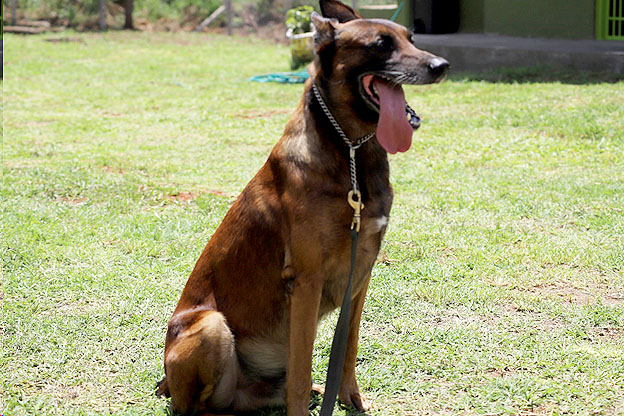
A sniffer dog
Detective Sergeant Kabarangira Mann is a commander of the Uganda Wildlife Authority (UWA) Canine Unit, where he has been working since 2016. In late March 2021, Sergeant Mann participated in an operation supported by African Wildlife Foundation (AWF) in Abim district where 24 kg of ivory (two pairs of elephant tusks) were seized and one suspect arrested, with the help of sniffer dogs. A week earlier, another AWF-supported operation led to the seizure of 98 kg of ivory (one pair of elephant tusks) from Fort Portal district, leading to the arrest of another suspect. While the seizure of these tusks and arrest of the suspects demonstrates success against poaching and illegal ivory trade, wildlife conservationists are grieving and mourning the death of three elephants — a critically endangered species with a slow reproduction rate of five to six years, and with the ability to stop reproducing when it senses that it is under threat. The greatest threat to the African elephant Loxodonta africana is wildlife crime, primarily poaching for the illegal ivory trade that is largely decimating their populations. In 1970, there was an estimated 1.4 million African elephants alive, but this number has since dropped to 415,000 today — an indication that these iconic species are at risk of vanishing from the African continent.
Using conservation dogs as a wildlife conservation tool
United States Agency for International Development (USAID) under the Combating Wildlife Crime (CWC) Activity implemented by Wildlife Conservation Society (WCS), African Wildlife Foundation (AWF), Natural Resource Conservation Network (NRCN) and The Royal United Services Institute (RUSI) aims to reduce crime against all wildlife species in Uganda by strengthening the capacity of stakeholders to detect, deter and prosecute wildlife crime. USAID CWC activity is contributing to this goal through its support to the dogs’ welfare, intelligence-led searches and wildlife detection dog trainings where it equips the dogs with skills to sniff out wildlife contraband. CWC is slated to train Uganda Wildlife Authority (UWA) dog handlers with skills to serve as credible witnesses in the courts of law. The activity also uses the dogs as a tool to provide evidence that the product is an actual specimen wildlife contraband, some of which include ivory, pangolin scales, hippo teeth and rhino horns. “This evidence is used to facilitate effective prosecution of wildlife cases,” says Abdullatif Mwanja, Activity Technical Advisor of the Canine Unit.
The journey to detect wildlife crime
Four days before the search operation was conducted, the UWA Canine Unit was tipped by an informant in Abim district about an imminent sale of ivory in the community. An investigation was launched and based on intelligence gathered, a plan was laid out and a seven-man team consisting of dog handlers and one sniffer dog, security personnel and AWF staff was mobilized and deployed. The full undercover operation that commenced in the morning ended at dusk with a dog search. When the dog was paraded before numerous sacks lined up in the suspect’s home, it led the team to one sack. When the sack was opened, there were two pairs of ivory. “This operation effectively demonstrates the strong bond between the handler and the dog where our dogs effectively respond to commands and directions and handlers understand their dogs’ cues and expressions,” says Sergeant Mann who exudes passion about the dogs when he talks about his work, emphasizing the importance of appreciating the dogs after any operation.

124 Kg of Elephant ivory seized in Uganda in March 2021.
Taking action to deter wildlife crime
The operations led to the arrest of one suspect from Fort Portal district and one suspect from Abim district. The suspects were arraigned in courts of law for prosecution on 7th and 11th April 2021 respectively; the cases are still ongoing. According to the revised Uganda Wildlife Act 2019, Section 71, the suspects face either a fine of UGX 20 billion shillings, life imprisonment or both, for being in possession of protected specimen from critically endangered species. According to Abdullatif, “Using sniffer dogs has been very effective at transport hubs because the dogs are able to intercept even the smallest product concealed in the shrewdest way”.